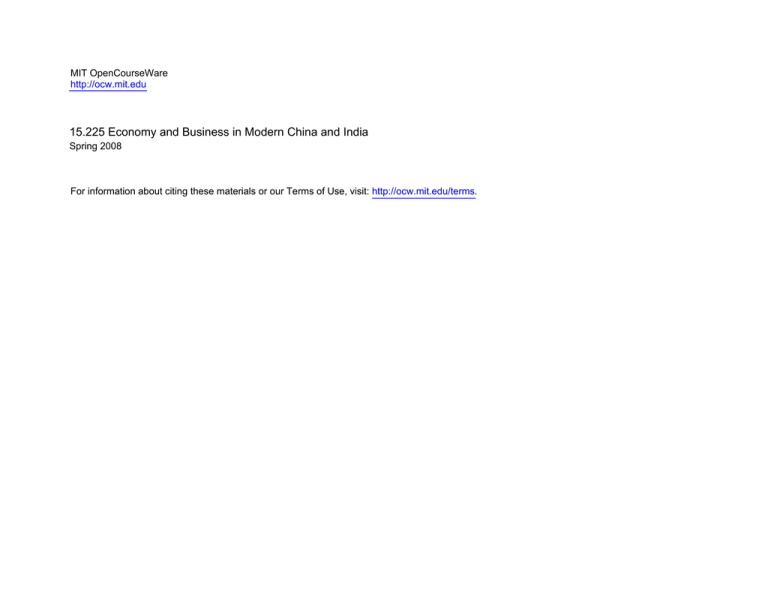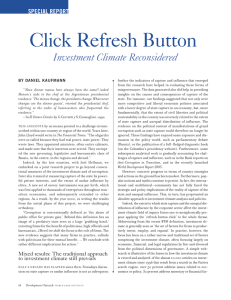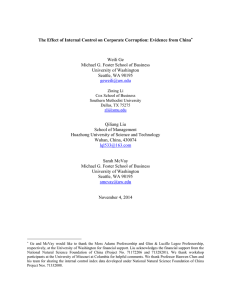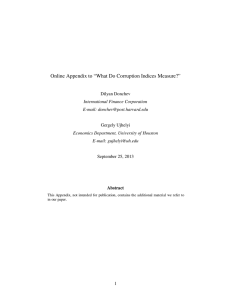____________ ________________ 15.225 Economy and Business in Modern China and India MIT OpenCourseWare
advertisement

MIT OpenCourseWare http://ocw.mit.edu ____________ 15.225 Economy and Business in Modern China and India Spring 2008 For information about citing these materials or our Terms of Use, visit: http://ocw.mit.edu/term ________________s. Final paper projects • You should write this paper as a part of a team. The optimal size of a team is between 2 to 4 persons. • Cross-section team formation is okay. • Please refer to Sloan Standards for guidance on plagiarism, etc. • Suggested length: 15-25 pages of text (Double space, 12 pt. font). 11/11/2008 1 Format and content • India and China are huge and complicated countries. – Your paper should be a focused treatment of a given topic, rather than a broad and superficial treatment of a topic. – You can compare the two countries but you should focus on one country and use the other country as a backdrop or to raise some broad implications. 11/11/2008 2 Format and content • An example of a focused paper while raising implications for the other country: –A detailed paper about the success of software industry in India and its success factors –At the end of the paper, you can offer some lessons for China in the following manner: • Make a note of the fact—very briefly—that software industry is not as well-developed • Make a case that China should make improvements in a number of areas, such as improving financing environment for small firms, promoting trust with foreign clients, etc. • Be explicit that this is based on your understanding of the success factors in India. • This format allows to focus on one country but also enables you to think about issues in the other country. 11/11/2008 3 Schedule • You should start thinking about your project ideas NOW. • Email your ideas to me and I will provide feedback. • The paper is due by 9 am four days after SES 13. •Your TA will acknowledge receiving your paper. You should check in with her if you do not get the receipt. •Late papers will be penalized. • No extensions granted except for extremely extenuating circumstances. 11/11/2008 4 SUGGESTED TOPICS FOR 15.225 • Human capital –What has happened in India’s rural basic education since reforms? •What has been done? • How much was spent? By federal governments? By states? • Why teachers do not show up? –India’s technical human capital: India is running out of skilled labor. • Too much demand? Or too little supply? • Mismatch between education and economy: Poor quality of training? –China/India comparison • Nilekani of Infosys: “We don’t necessarily look for people that have the exact skills we need.” Instead, we hire people that have the quality of ‘learnability’ and then we teach them the requisite skills.” • Which country’s educational system does a better job teaching “learnability” and creativity, as opposed to specific skills? • Why is there a surplus of college graduates in China but a shortage of collage graduates in India? 11/11/2008 5 SUGGESTED TOPICS FOR 15.225 • Corruption –Which country has done a better job controlling corruption? –How to measure? • Transparency international, World Bank indicators • Dollar amount of the actual corruption cases • Role of transparency through media vis-à-vis the role of monitoring through bureaucracy. 11/11/2008 6 SUGGESTED TOPICS FOR 15.225 • Competitiveness • Can you find objective measures of competitiveness? Patents? – Which area of India/China is most competitive in producing patents? And why? –What kind of patents are these? By foreign firms? By domestic firms? Invention or utility? • How to improve “soft” environment such as reducing corruption? – What do the international survey data say about corruption in China and India? –Can you find more objective measures, such as actual instances of corruption? –Which industry/government department/political branch is most corrupt? –Compare the worst corruption cases in the two countries? Worst in terms of amount, effect or political rank of those involved. 11/11/2008 7 SUGGESTED TOPICS FOR 15.225 • Property rights • How has India been able to develop some industrial parks when real estate transactions are so difficult? – What are the specific approaches—negotiation, collective bargaining, market-based transactions? –How to solve hold-up problems? –Lessons for each other? Can China learn from India’s more “negotiated” approach? • Financial system – How do you characterize the lending practices by the banks in these two countries? Collateral or cashflow-based? –Compare and contrast the systems of credit information collection and dissemination in the two countries. –How to overcome poor information about small-scale entrepreneurial borrowers? What are some of the innovative methods? – • 11/11/2008 8 SUGGESTED TOPICS FOR 15.225 • Management models –Compare and contrast the ways the firms in the two countries retain valued human capital –Which countries have a more top-down/bottom-up management models among successful firms? • Does Infosys delegate? • Does Lenovo delegate? • How have the firms in the two countries make the transition from the founder stage to professional management stage? • Labor-intensive industries • Why India can produce software but not shirts? • Why labor reforms in India are so slow? Is labor market the problem or skilled labor or infrastructure? • What have the Chinese firms done in branding and marketing in the labor-intensive industries? 11/11/2008 9







